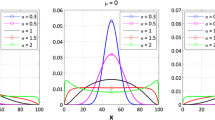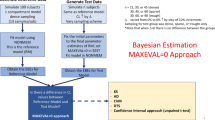Abstract
The influence of the choice of pharmacokinetic model on subsequent determination of covariate relationships in population pharmacokinetic analysis was studied using both simulated and real data sets. Simulations and data analysis were both performed with the program NONMEM. Data were simulated using a two-compartment model, but at late sample times, so that preferential selection of the two-compartment model should have been impossible. A simple categorical covariate acting on clearance was included. Initially, on the basis of a difference in the objective function values, the two-compartment model was selected over the one-compartment model. Only when the complexity of the one-compartment model was increased in terms of the covariate and statistical models was the difference in objective function values of the two structural models negligible. For two real data sets, with which the two-compartment model was not selected preferentially, more complex covariate relationships were supported with the one-compartment model than with the two-compartment model. Thus, the choice of structural model can be affected as much by the covariate model as can the choice of covariate model be affected by the structural model; the two choices are interestingly intertwined. A suggestion on how to proceed when building population pharmacokinetic models is given.
Similar content being viewed by others
References
S. L. Beal and L. B. Sheiner (eds.)NONMEM Users Guides, NONMEM Project Group, University of California, San Francisco, 1992.
L. B. Sheiner, B. Rosenberg, and K. L. Melmon. Modelling of individual pharmacokinetics for computer-aided drug dosage.Comp. Biomed. Res. 5:441–459 (1972).
L. Aarons, S. Vozeh, M. Wenk, P. Weiss, and F. Follath. Population pharmacokinetics of tobramycin.Br. J. Clin. Pharmacol. 28:305–314 (1989).
J. Antal, T. H. Grasela, and R. B. Smith. An evaluation of population pharmacokinetics in therapeutic trials. Part III. Prospective data collection versus retrospective data assembly.Clin. Pharmacol. Ther. 46:552–559 (1989).
L. Collart, T. F. Blaschke, F. Boucher, and C. G. Prober. Potential of population pharmacokinetics to reduce the frequency of blood sampling required for estimating kinetic parameters in neonates.Dev. Pharmacol. Ther. 18:71–80 (1992).
K. Fattinger, S. Vozeh, A. Olafsson, J. Vlcek, M. Wenk and F. Follath. Netilmicin in the neonate: population pharmacokinetic analysis and dosing recommendations.Clin. Pharmacol. Ther. 50:55–65 (1991).
K. Fattinger, S. Vozeh, H. R. Ha, M. Borner, and F. Follath. Population pharmacokinetics of quinidine.Br. J. Clin. Pharmacol. 31:279–286 (1991).
H. Fluhler, H. Huber, E. Widmer, and S. Brechbuhler. Experiences in the application of NONMEM to pharmacokinetic data analysis.Drug Met. Rev. 15:317–339 (1984).
S. R. Gitterman, G. L. Drusano, M. J. Egorin, H. C. Standiford, and the Veterans Administration Cooperative Studies Group. Population pharmacokinetics of zidovudine.Clin. Pharmacol. Ther. 48:161–167 (1990).
T. H. Grasela, E. J. Antal, R. J. Townsend, and R. B. Smith. An evaluation of population pharmacokinetics in therapeutic trials. Part I. Comparison of methodology.Clin. Pharmacol. Ther. 39:605–612 (1986).
T. H. Grasela, E. J. Antal, L. Ereshefsky, B. G. Wells, R. L. Evans, and R. B. Smith. An evaluation of population pharmacokinetics in therapeutic trials. Part, II. Detection of a drug-drug interaction.Clin. Pharmacol. Ther. 42:433–441 (1987).
D. A. Graves and I. Chang. Application of NONMEM to routine bioavailability data.J. Pharmacokin. Biopharm. 18:145–160 (1990).
N. M. Graves, T. M. Ludden, G. B. Holmes, R. H. Fuerst, and I. E. Leppik. Pharmacokinetics of felbamate, a novel antiepileptic drug: application of mixed-effect modelling to clinical trials.Pharmacotherapy 9:372–376 (1989).
J. Grevel, B. Whiting, A. W. Kelman, W. B. Taylor, and D. N. Bateman. Population analysis of the pharmacokinetic variability of high-dose metoclopramide in cancer patients.Clin. Pharmacokin. 14:52–63 (1988).
J. Grevel, P. Thomas, and B. Whiting. Population pharmacokinetic analysis of bisoprolol.Clin. Pharmacokin. 17:53–63 (1989).
M. Izquierdo, J. M. Lanao, L. Cervero, N. V. Jiminez, and A. Dominguez-Gil. Population pharmacokinetics of gentamicin in premature infants.Ther. Drug Monit. 14:177–183 (1992).
P. D. Jensen, B. E. Edgren, and R. C. Brundage. Population pharmacokinetics of gentamicin in neonates using a nonlinear, mixed-effects model.Pharmacotherapy 12:178–182 (1992).
D. M. Jermain, M. L. Crismon, and E. S. Martin III Population pharmacokinetics of lithium.Clin. Pharm. 10:376–381 (1991).
M. C. Launay, A. Iliadis, and B. Richard. Population pharmacokinetics of mitoxantrone performed by a NONMEM method.J. Pharm. Sci. 78:877–880 (1989).
E. S. Martin III, M. L. Crismon, and P. J. Godley. Postinduction carbamazepine clearance in an adult psychiatric population.Pharmacotherapy 11:296–302 (1991).
S. M. Pai, U. A. Shukla, T. H. Grasela, C. A. Knupp, R. Dolin, F. T. Valentine, C. McLaren, H. A. Lieberman, R. R. Martin, K. A. Pittman, and R. H. Barbhaiya. Population pharmacokinetic analysis of Didanosine (2′, 3′-dideoxyinosine) plasma concentrations obtained in phase I clinical trials in patients with AIDS or AIDS-related complex.J. Clin. Pharmacol. 32:242–247 (1992).
L. B. Sheiner, B. Rosenberg, and V. V. Marathe. Estimation of population characteristics of pharmacokinetic parameters from routine clinical data.J. Pharmacokin. Biopharm. 5:445–479 (1977).
D. R. Stanski, and P. O. Maitre. Population pharmacokinetics and pharmacodynamics of thiopental: The effect of age revisited.Anaesthesiology 72:412–422 (1990).
M. Tamayo, M. M. Fernandez de Gatta, M. J. Garcia, and A. Dominguez-Gil. Population pharmacokinetics of imipramine in children.Eur. J. Clin. Pharmacol. 43:89–92 (1992).
C. N. Verme, T. M. Ludden, W. A. Clementi, and S. C. Harris. Pharmacokinetics of quinidine in male patients: a population analysis.Clin. Pharmacokin. 22:468–480 (1992). and Erratum,Clin. Pharmacokin. 23:68 (1982).
S. Vozeh, M. Wenk, and F. Follath. 2. Experience with NONMEM: analysis of serum concentration data in patients treated with mexiletine and lidocaine.Drug Met. Rev. 15:305–315 (1984).
J. R. Wade, A. W. Kelman, D. J. Kerr, J. Robert, and B. Whiting. Variability in the pharmacokinetics of epirubicin: a population analysis.Cancer Chemother. Pharmacol. 29:391–395 (1992).
D. B. Wiest, J. B. Pinson, P. S. Gal, R. C. Brundage, S. Schall, J. L. Ransom, R. L. Weaver, D. Purohit, and Y. Brown. Population pharmacokinetics of intravenous indomethacin in neonates with symptomatic patent ductus arteriosus.Clin. Pharmacol. Ther. 49:550–557 (1991).
P. J. Williams, J. Lane, W. Murray, M. A. Mergener, and M. Kamigaki. Pharmacokinetics of the digoxin-quinidine interaction via mixed-effect modelling.Clin. Pharmacokin. 22:66–74 (1992).
E. Yukawa, S. Higuchi, and T. Aoyama. Phenobarbitone population pharmacokinetics from routine clinical data: role of patient, characteristics for estimating dosage regimens.J. Pharm. Pharmacol. 44:755–760 (1992).
E. Yukawa, H. Mine, S. Higuchi, and T. Aoyama. Digoxin population pharmacokinetics from routine clinical data: role of patient characteristics for estimating dosage regimens.J. Pharm. Pharmacol. 44:761–765 (1992).
G. J. Yuen, G. L. Drusano, J. Brooks, and S. Flor. Use of nonlinear, mixed-effects modelling for population analysis of ofloxacin: effects of age on oral drug pharmacokinetics.Pharmacotherapy 12:88–92 (1992).
M. Rowland and T. N. Tozer.Clinical Pharmacokinetics: Concepts and Applications, 2nd ed., Lea and Fabiger, Philadelphia, PA, 1989, p. 447.
Author information
Authors and Affiliations
Additional information
Supported by National Institutes of Health grants GM 26691 and GM 26676
Rights and permissions
About this article
Cite this article
Wade, J.R., Beal, S.L. & Sambol, N.C. Interaction between structural, statistical, and covariate models in population pharmacokinetic analysis. Journal of Pharmacokinetics and Biopharmaceutics 22, 165–177 (1994). https://doi.org/10.1007/BF02353542
Received:
Accepted:
Published:
Issue Date:
DOI: https://doi.org/10.1007/BF02353542




